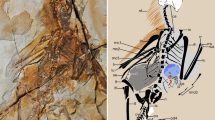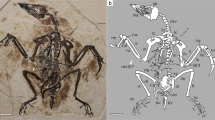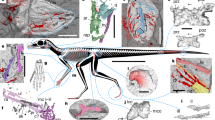Abstract
AVIAN flight is one of the most remarkable achievements of vertebrate evolution, yet there is little evidence of its early phases. Specimens of Archaeopteryx shed important (albeit controversial) light on this evolutionary phenomenon, but the large morphological (and almost certainly functional) gap between Archaeopteryx and modern avians remained virtually empty until recently. Here we report a new, exquisitely preserved, bird from the Lower Cretaceous Konservat-Lagerstätte of Las Hoyas (Cuenca, Spain) which provides evidence for the oldest known alula (bastard wing). Crustacean remains found inside its belly also provide the oldest direct evidence of feeding habits in birds. The new specimen has numerous synapomorphies with the Enantiornithes, but its unique sternal morphology, along with other autopomorphies in the furcula and vertebral centra, support the recognition of a new enantiornithine taxon, Eoalulavishoyasi. The combination in Eoalulavis of a decisive aerodynamic feature, such as the alula, with the basic structures of the modern flight apparatus indicates that as early as 115 million years ago, birds had evolved a sophisticated structural system that enabled them to fly at low speeds and to attain high manoeuvrability.
This is a preview of subscription content, access via your institution
Access options
Subscribe to this journal
Receive 51 print issues and online access
$199.00 per year
only $3.90 per issue
Buy this article
- Purchase on Springer Link
- Instant access to full article PDF
Prices may be subject to local taxes which are calculated during checkout
Similar content being viewed by others
References
Sanz, J. L. & Bonaparte, J. F. in Papers in Avian Paleontology Honoring Pierce Brodkorb (ed. Campbell, K. E. Jr) 39–49 (Nat. Hist. Mus. Los Angeles, Sci. Ser. 36, Los Angeles, 1992).
Sanz, J. L., Bonaparte, J. F. & Lacasa, A. Nature 331, 433–435 (1988).
Sanz, J. L. & Buscalioni, A. D. Palaeontology 35, 829–845 (1992).
Sanz, J. L., Chiappe, L. M. & Buscalioni, A. D. Am. Mus. Novit. 3133, 23 (1995).
Fregenal-Martínez, M. A. & Meléndez, N. in Las Hoyas: A Lacustrine Konservat-Lagerstätte, Cuenca, Spain. Field Trip Guide Book (ed. Meléndez, N.) 1–10 (Universidad Complutense de Madrid, Spain, 1995).
Chiappe, L. M. Nature 378, 349–355 (1995).
Chiappe, L. M. & Calvo, J. O. J. Vert. Paleont. 14, 230–246 (1994).
Pérez-Moreno, B. P., Sanz, J. L., Buscalioni, A. D., Moratalla, J. J., Ortega, F. & Rasskin-Gutman, D. Nature 370, 363–367 (1994).
McGowan, G. & Evans, S. E. Nature 373, 143–145 (1995).
Martin, L. D. & Tate, J. Jr Smithson. Contr. Paleobiol. 27, 35–66 (1976).
Nachtigall, W. & Kempf, B. Z. vergl. Physiol. 71, 326–341 (1971).
Graham, R. R. J. R. aero. Soc. 36, 598–600 (1932).
Brown, R. H. J. Biol. Rev. 38, 460–489 (1963).
Hecht, M. K., Ostrom, J. H., Viohl, G. & Wellnhofer, P. (eds) The Beginnings of Birds (Jura Museum, Eichstätt, 1985).
Feduccia, A. Science 259, 790–793 (1993).
Speakman, J. R. Evolution 47, 336–340 (1993).
Speakman, J. R. & Thomson, S. C. Nature 370, 514 (1994).
Norberg, R. Å., Speakman, J. R. & Thomson, S. C. Nature 374, 221–222 (1995).
Vázquez, R. J. J. Morphol. 211, 259–268 (1992).
Rayner, J. M. V. in Biomechanics in Evolution (eds Rayner, J. M. V. & Wootton, R. J.) 183–212 (Cambridge Univ. Press, 1991).
Ostrom, J. H. Biol. J. Linn. Soc. Lond. 8, 91–182 (1976).
Chiappe, L. M. Müchuer Geowissenschafiche Abhandlungen (A) 30, 203–244 (Verlag Dr Friedrich Pfeil, 1966).
Maisey, J. G., Rutzky, I., Blum, S. & Elvers, W. in Santana Fossils. An Illustrated Guide (ed. Maisey, J. G.) 98–105 (T.F.H. Publications, New York, 1991).
Farris, J. Hennig 86 references. Documentation for version 1.5. (Privately published, 1988).
Zhou, Z. Cour. Forschungsinst. Senckenberg 181, 9–22 (1995).
Olson, S. L. & Feduccia, A. Nature 278, 247–248 (1979).
Davis, P. G. & Briggs, D. E. G. Geology 23, 783–786 (1995).
Spearman, R. I. C. & Hardy, J. A. in Form and Function in Birds Vol. 3 (eds King, A. S. & McLelland, J.) 1–56 (Academic, London, 1985).
Author information
Authors and Affiliations
Rights and permissions
About this article
Cite this article
Sanz, J., Chiappe, L., Pérez-Moreno, B. et al. An Early Cretaceous bird from Spain and its implications for the evolution of avian flight. Nature 382, 442–445 (1996). https://doi.org/10.1038/382442a0
Received:
Accepted:
Issue Date:
DOI: https://doi.org/10.1038/382442a0
Comments
By submitting a comment you agree to abide by our Terms and Community Guidelines. If you find something abusive or that does not comply with our terms or guidelines please flag it as inappropriate.



